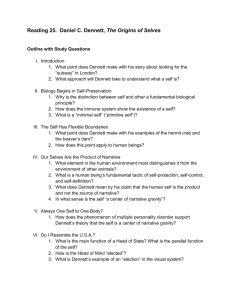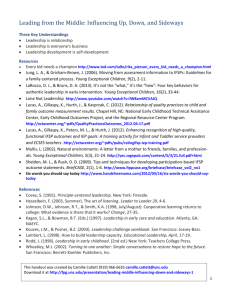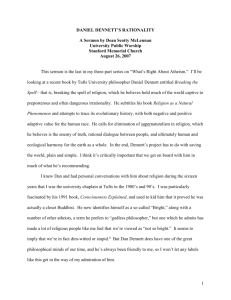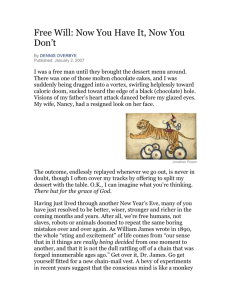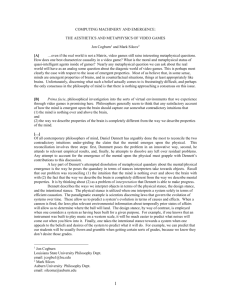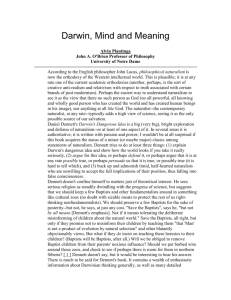Word - University of Arkansas
advertisement
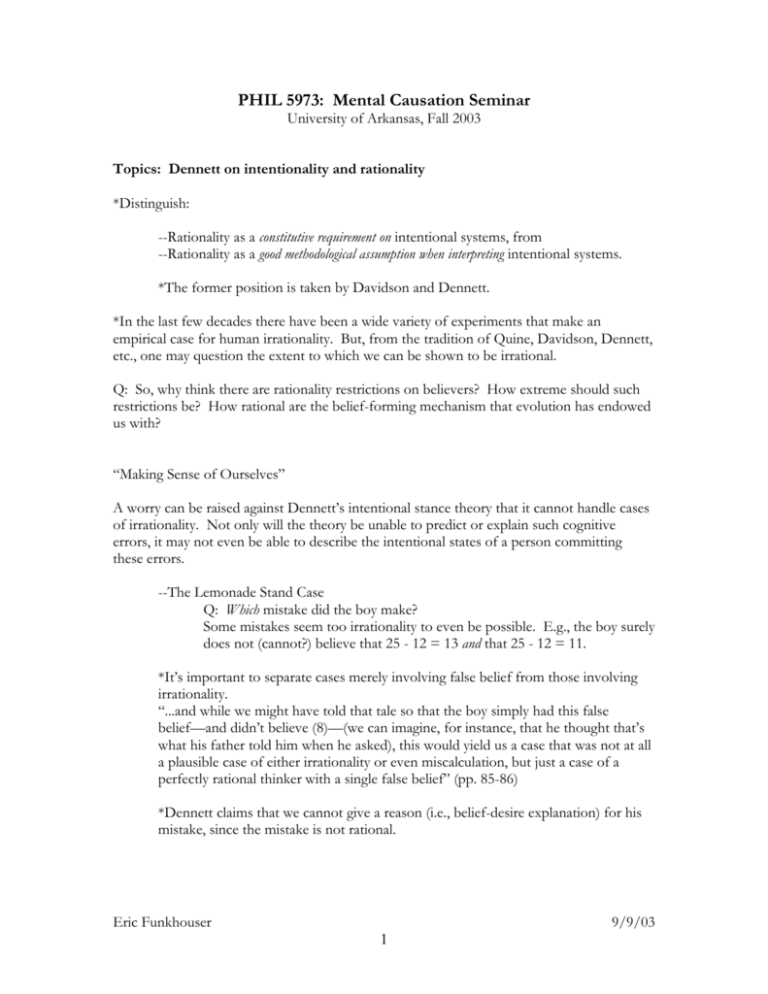
PHIL 5973: Mental Causation Seminar University of Arkansas, Fall 2003 Topics: Dennett on intentionality and rationality *Distinguish: --Rationality as a constitutive requirement on intentional systems, from --Rationality as a good methodological assumption when interpreting intentional systems. *The former position is taken by Davidson and Dennett. *In the last few decades there have been a wide variety of experiments that make an empirical case for human irrationality. But, from the tradition of Quine, Davidson, Dennett, etc., one may question the extent to which we can be shown to be irrational. Q: So, why think there are rationality restrictions on believers? How extreme should such restrictions be? How rational are the belief-forming mechanism that evolution has endowed us with? “Making Sense of Ourselves” A worry can be raised against Dennett’s intentional stance theory that it cannot handle cases of irrationality. Not only will the theory be unable to predict or explain such cognitive errors, it may not even be able to describe the intentional states of a person committing these errors. --The Lemonade Stand Case Q: Which mistake did the boy make? Some mistakes seem too irrationality to even be possible. E.g., the boy surely does not (cannot?) believe that 25 - 12 = 13 and that 25 - 12 = 11. *It’s important to separate cases merely involving false belief from those involving irrationality. “...and while we might have told that tale so that the boy simply had this false belief—and didn’t believe (8)—(we can imagine, for instance, that he thought that’s what his father told him when he asked), this would yield us a case that was not at all a plausible case of either irrationality or even miscalculation, but just a case of a perfectly rational thinker with a single false belief” (pp. 85-86) *Dennett claims that we cannot give a reason (i.e., belief-desire explanation) for his mistake, since the mistake is not rational. Eric Funkhouser 9/9/03 1 *Contrast cases in which people acknowledge and correct their error, with those in which they do not acknowledge the error and (unabashedly) persist in making similar errors. *In “Reflections”, Dennett insists that in cases of cognitive error, like the lemonade seller, there is no fact of the matter about one believes. But this indeterminacy is comparable (and related to) the indeterminacy in language translation that Quine noted. (p. 104) Q: Why does Dennett make this comparison in the context of cognitive error? This indeterminacy should hold even when such error is absent, right? *Forgetting, as a hypothesis that avoids the charge of irrationality: The Tennis Date with Paul (pp. 88-89) *We even apply the intentional stance to ourselves, and do not have direct, and certainly not infallible, access to our own belief/desire states. (p. 91) *Belief/desire attribution must be holistic. And it is not at all straight-forward how we should interpret “sentences in the head”. Example: Jones’ claim that “It is raining.” (pp. 92-93) *How strong should the rationality constraints on belief/desire attribution be? Stich argues that requiring logical consistency and/or deductive closure is too strong. (p. 94) And it would be too weak were we to count everything that evolution provided us with as rational. *Dennett claims that he can appropriately insist that rationality is at the core of intentionality, while nevertheless not owing us an account of the nature of rationality when presenting his theory of intentionality. Why does he think this? *Dennett claims that evolution guarantees that most of our beliefs will be true, and our belief-forming mechanisms rational. --But the standards for rationality shouldn’t be the “intro. logic” standards. (Note Dennett’s comments about satisficing, and the benefits (in terms of diminished calculations) of sometimes leaping to conclusions.) Nor should the standards be those of any other formal system, as rationality is a pretheoretic concept. (pp. 96-98) --“I want to use “rational” as a general-purpose term of cognitive approval.” (p. 97) --The dispute with Stich: Stich: We attribute beliefs and desires to other people by projecting ourselves into their position and asking what we would believe/desire in that position. Eric Funkhouser 9/9/03 2 Dennett: We attribute beliefs and desires to other people by asking what a rational person would believe/desire in that position. *On pp. 99-101 Dennett provides cases where his procedure might diverge from Stich’s procedure, but also suggests that Stich’s procedure might reduce to his. In “Reflections”, Dennett returns to the lemonade seller and frog cases and the question of what they really believe. Here he takes on Realism again. *What is the content of a frog’s belief? E.g., that there is food to the right, an insect, a physical object, etc.? --Compare to the thermostat case, or a dog chasing a squirrel up a tree. *Prior question: Do frogs even see? Dennett provides a fascinating example of a prosthetic vision device in order to test our intuitions about what counts as “real” seeing. (pp. 106-107) (Dennett also uses this example to cast aspersion upon the notion of qualia.) *A return to the illata/abstracta distinction: “...it no doubt seems that the categories of frog biology have a more robust reality than the categories of frog psychology. You can see the frog’s nervous system, after all. You can individuate the neurons under a high-powered microscope and measure the state a neuron is in with an implanted microelectrode.” (p. 109) --Q: Does seeing make these alleged things more real? This is a bad approach to metaphysics. Does seeing the mereological sum of your left ear and the Eiffel Tower make it more real? *The Realist thinks that there is one objectively true way of specifying the propositional content of any belief. Language makes it possible for us to have thoughts with such precise and sophisticated content. “But the guiding Realist vision of “propositional attitude psychology” of human beings is still for many people in stark contrast to what it seems comfortable to acknowledge in the case of the frog as an intentional system: an intentional stance characterization of a frog is always an idealization, and any idealization will fit the brute facts at the physical or design level only so well. Beyond the facts about just where and how the best approximation at the intentional level proves to be misleading, there simply are no facts about what the frog “really believes.” The strategy, applied to a frog, neither needs nor permits that sort of precision.” (p. 116) “Intentional Systems in Cognitive Ethology: The “Panglossian Paradigm” Defended” *Ethologists used to be staunch Behaviorists and rejected mentalistic attributions to animals (e.g., for methodological restrictions to what is observable). *2 features of intentionality: referential opacity and rationality. Eric Funkhouser 9/9/03 3 *A real-world case of radical translation: vervet monkeys. *Dennnett distinguishes between different orders of intentionality. (p. 243) This is an interesting distinction, because it seems to relate to the issue of communication/linguistic behavior. It does seem that third-order intentionality is necessary for linguistic behavior. (Second-order intentionality seems sufficient only for manipulation?) So, the intentional interpretation of the vervet monkeys will shed some light on whether they are actually communicating in a language. (p. 244) *Example: Tom the vervet monkey gives a leopard call in the presence of Sam the vervet. --Q: Which order of intentionality is appropriate for this case? (And how should we characterize the content of these intentional states?) *What kind of evidence will help settle the intentional interpretation? For one, do vervets make these calls when, for all they “know”, they are alone? They do not. This is evidence for “promoting” them to a higher-order of intentionality. Also consider the case of the false alarm during the vervet-battle (p. 248) Can other vervets detect, and then mistrust, vervets who give out false alarms? *We should employ the Sherlock Holmes Method—that is, devise tricks (experiments) to discover the “intentional profile” of a system. Examples: the possibly deceptive behavior of chimps (pp. 253-254) and dead-bee-removal (p. 256) *Many comparisons can be made between intentional systems theory and evolutionary theory. First note that the same vocabulary (e.g., rationalizing, intentionalistic vocabulary) is used in each domain. Dennett introduces this point by giving the example of groundnesting birds that engage in “distraction display.” Even if the individual bird doesn’t fit the intentional description, Dennett claims that we can go up a level and attribute the intentional description to the species. E.g., the species learned to employ this strategy to solve a problem. *Just as the norm of rationality governs Dennett’s intentional systems theory, the norm of optimization governs the adaptationist’s evolutionary theory. Dennett notes many parallels between criticisms of rationality-based intentional psychology and adaptationism-based evolutionary theory (i.e., the Panglossian Paradigm). B.F. Skinner and Gould/Lewontin are the representative critics, respectively. Criticisms: 1. Each theory is mere “storytelling.” Basically, each theory is unfalsifiable, given enough creativity by the theorist (p. 262) 2. Each theory ignores the mechanistic details that provide the “real” explanations. 3. Each theory has been over-extended. That is, obviously false examples of intentionalistic and adaptationist explanations have been offered. 4. Their explanations are ex post facto. Eric Funkhouser 9/9/03 4 *Against 1 and 4: Dennett properly notes that these theorists typically do not simply revise their “stories” ex post facto. These theorists simply do make informative predictions from these “stances” that could not be made from merely taking a more mechanistic or historical approach to the matter. *Against 3: We can concede the counter-examples. Such over-extensions are inappropriate, but this in no way damages the theory itself. *Against 2: Dennett claims that the mechanistic (e.g., physical stance) approach and the intentional stance approach answer different “Why?” questions. The mechanistic approach provides an historical answer—e.g., for why this particular action was performed or why we find this type of spot on the moth. Such a story will talk about muscle behavior, neuron firing, and the like, in the case of human action, and mutations, births, and the like, in the case of evolution of moth spots. But these explanations answer different questions than the rationalizing explanations of intentional systems theory and adaptationism. Eric Funkhouser 9/9/03 5

